
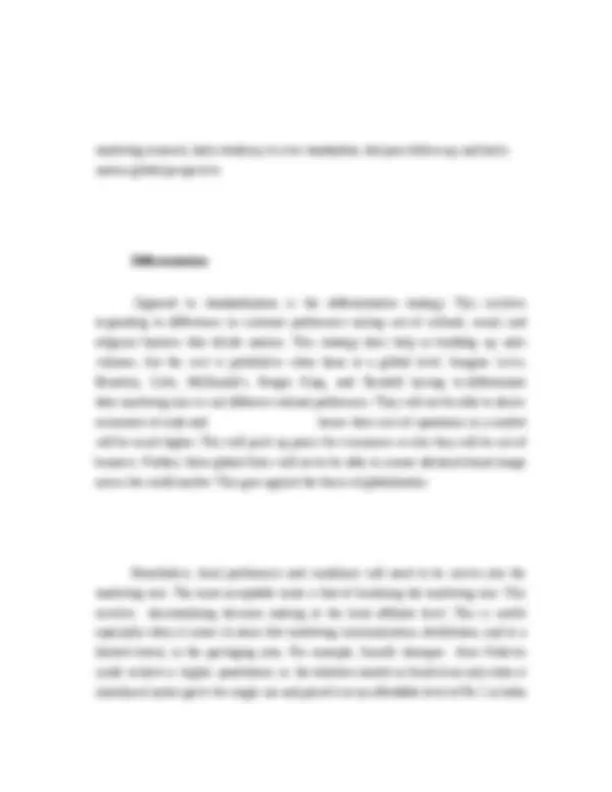

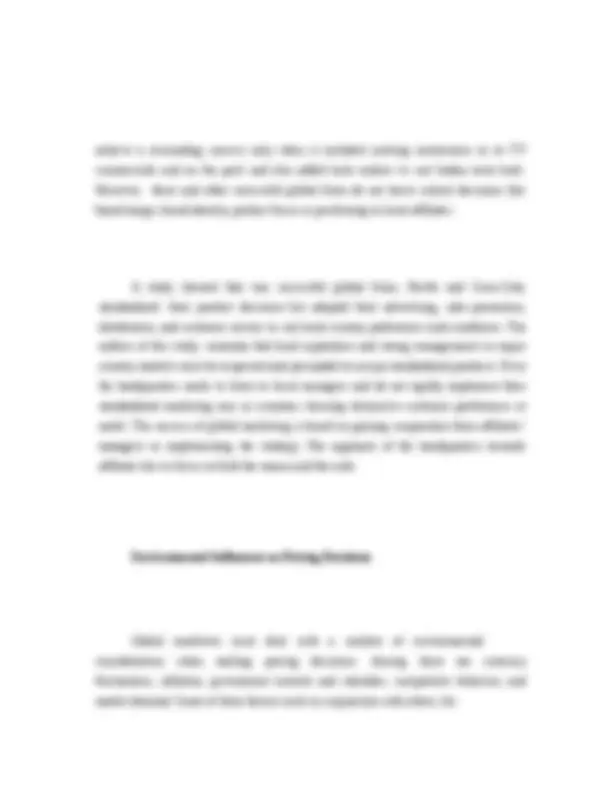



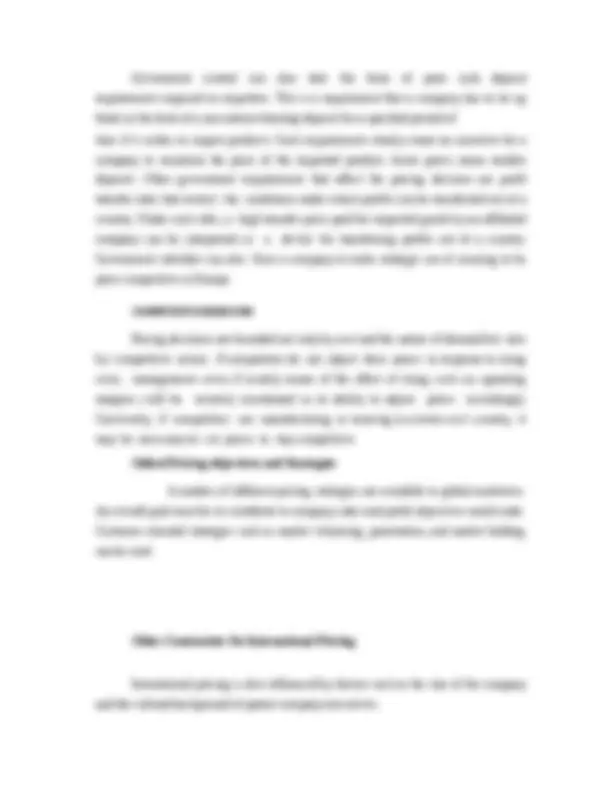
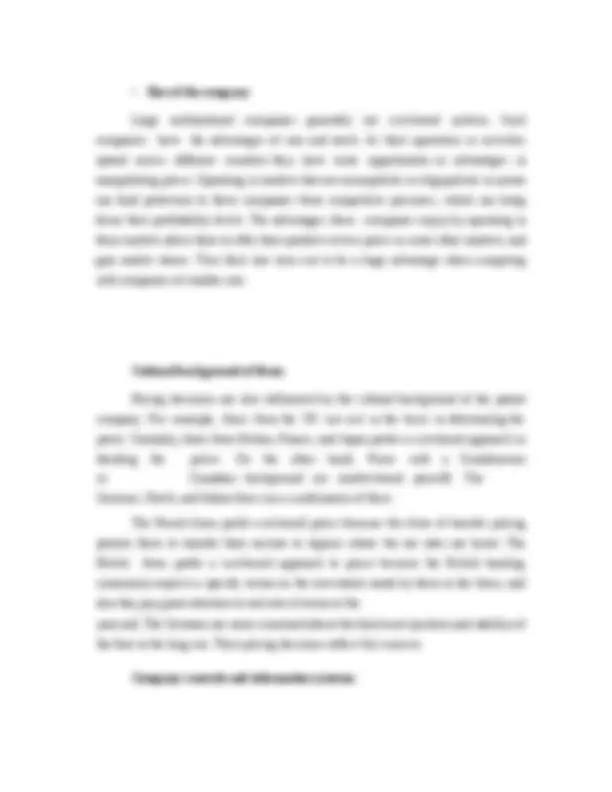
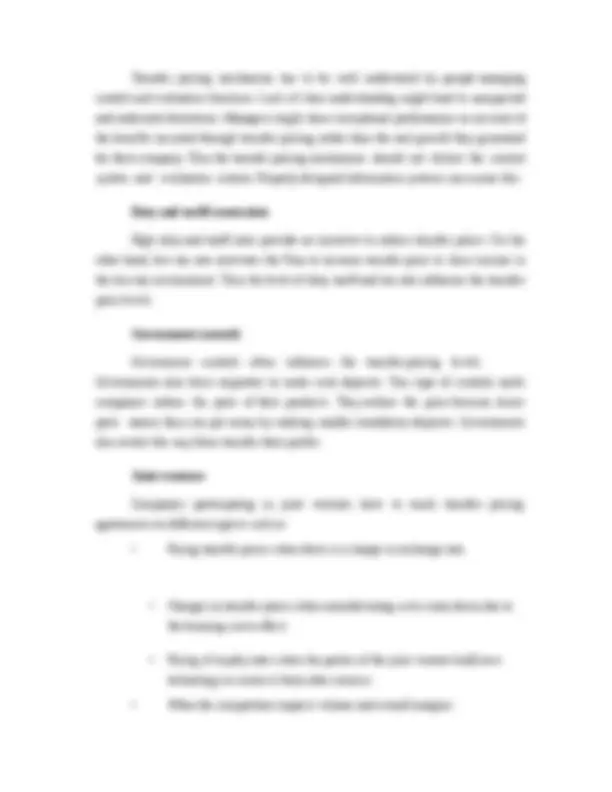


Study with the several resources on Docsity

Earn points by helping other students or get them with a premium plan


Prepare for your exams
Study with the several resources on Docsity

Earn points to download
Earn points by helping other students or get them with a premium plan
Community
Ask the community for help and clear up your study doubts
Discover the best universities in your country according to Docsity users
Free resources
Download our free guides on studying techniques, anxiety management strategies, and thesis advice from Docsity tutors
Standardized marketing mix involves developing a standard product and arketing it across the national border with the same communication, pricing, and dstribution trategy With the advent and standardization of technology and more specifically that of communications, customer needs are globally getting homogenized.
Typology: Study notes
1 / 16

This page cannot be seen from the preview
Don't miss anything!










Standardization Vs Differentiation
Standardization Standardized marketing mix involves developing a standard product and marketing it across the national border with the same communication, pricing, and distribution strategy. With the advent and standardization of technology and more specifically that of communications, customer needs are globally getting homogenized. This process or homogenization of needs is getting accelerated as trade barriers come down one after another leading to globalization of markets. Worldwide communication has raised customers‘ expectations and demands for better living standards, work life, and entertainment. This cuts across cultures and religions. Nothing better confirms this than the success of brands like Coke, Pepsi, Levis, Benetton readymade garments, Sony and Panasonic electronic items, and even Hollywood films and soap operas made in the US and different parts of the world that have diverse cultures and religions. These commonalities in customer preferences lead conclusively to the standardization route in corporate strategy.
Standardization helps the firm not only reduce its costs but also to ensure superior quality and consistent brand image across the world market. It helps the firm achieve economies of scale which is not possible in any other approach. 4 Japanese firms have relentlessly pursued this strategy and gained substantial scale economies, often at the expense of their rivals. Global firms compete in different national markets through a standardization strategy and offer appropriate volume—the best combination of price, quality, reliability, and delivery of products.
However, there are pitfalls in this decision. A study shows that the success of a global firm is based on how global decisions are conceptualized, refined, internally communicated, and implemented across the world market. It concludes that firms which lose out in the global marketing warfare are the ones that insufficiently used
and comparable level in other South Asian countries as well. Maggi noodles, marketed by Nestle, could
achieve a resounding success only when it included cooking instructions in its TV commercials and on the pack and also added taste makers to suit Indian taste buds. However, these and other successful global firms do not leave critical decisions like brand image, brand identity, product focus or positioning to local affiliates.
A study showed that two successful global firms, Nestle and Coca-Cola, standardized their product decisions but adapted their advertising, sales promotion, distribution, and customer service to suit local country preferences and conditions .The authors of this study maintain that local aspirations and strong managements in major country markets must be respected and persuaded to accept standardized products. Even the headquarters needs to listen to local managers and do not rigidly implement their standardized marketing mix in countries showing distinctive customer preferences or needs. The success of global marketing is based on gaining cooperation from affiliates‘ managers in implementing the strategy. The approach of the headquarters towards affiliates has to focus on both the means and the ends.
Environmental Influences on Pricing Decisions
Global marketers must deal with a number of environmental considerations when making pricing decisions. Among these are currency fluctuations, inflation, government controls and subsidies, competitive behavior, and market demand. Some of these factors work in conjunction with others; for
example, inflation may be accompanied by government controls. Each consideration is discussed in detail next.
Currency Fluctuations
Fluctuating currency values are fact of life in international business. The marketer must decide what to do about this fact. When currency fluctuations result in appreciation in the value of the currency of a country that is an exporter, wise companies do two things: They accept that currency fluctuations may unfavorably impact operating margins, and
When Domestic Currency I s
When Domestic Currency
Stress price benefits. competitionEngage by in^ improvingnonprice
Exploit market Give priority to exports to
actual practice, a manufacturer and its distributor may work together to maintain market share in international market. If a country‘s currency weakens relative to a trading partner's currency, a producer in a weak-currency country can cut export prices to hold market share or leave prices alone for healthier profit margins.
Exchange Rate Clauses
Many sales are contracts to supply goods or services over time. When these contracts are between parties in two countries, the problem of exchange rate fluctuations and exchange risk must be addressed.
An exchange rate clause allows the buyer and seller to agree to supply and purchase at fixed prices in each company‘s national currency. If the exchange rate fluctuates within a specified range, say plus or minus 5 percent, the fluctuations do not affect the pricing agreement that is spelled out in the exchange rate clause. Small fluctuations in exchange rates are not a problem for most buyers and sellers. Exchange rate clauses are designed to protect both the buyer and the seller from unforeseen large swings in currencies.
Pricing In An Inflationary Environment
Government control can also take the form of prior cash deposit requirements imposed on importers. This is a requirement that a company has to tie up funds in the form of a non-interest-bearing deposit for a specified period of
time if it wishes to import products. Such requirements clearly create an incentive for a company to minimize the price of the imported product; lower prices mean smaller deposits. Other government requirements that affect the pricing decision are profit transfer rules that restrict the conditions under which profits can be transferred out of a country. Under such rules, a high transfer price paid for imported goods by an affiliated company can be interpreted as a device for transferring profits out of a country. Government subsidies can also force a company to make strategic use of sourcing to be price competitive in Europe.
COMPETITIVE BEHAVIOR Pricing decisions are bounded not only by cost and the nature of demand but also by competitive action. If competitors do not adjust their prices in response to rising costs, management—even if acutely aware of the effect of rising costs on operating margins—will be severely constrained in its ability to adjust prices accordingly. Conversely, if competitors are manufacturing or sourcing in a lower-cost country, it may be necessary to cut prices to stay competitive.
Global Pricing objectives and Strategies A number of different pricing strategies are available to global marketers. An overall goal must be to contribute to company sales and profit objectives world wide. Customer oriented strategies such as market skimming, penetration, and market holding can be used.
Other Constraints On International Pricing
International pricing is also influenced by factors such as the size of the company and the cultural background of parent company executives.
Cultural background of firms Pricing decisions are also influenced by the cultural background of the parent company. For example, firms from the US use cost as the basis in determining the prices. Similarly, firms from Britain, France, and Japan prefer a cost-based approach in deciding the prices. On the other hand, Firms with a Scandinavian or Canadian background use market-based pricesl6. The Germans, Dutch, and Italian firms use a combination of these.
The French firms prefer cost-based prices because this form of transfer pricing permits them to transfer their income to regions where the tax rates are lower. The British firms prefer a cost-based approach to prices because the British banking community expects a specific return on the investment made by them in the firms, and also they pay great attention to real rate of return at the year-end. The Germans are more concerned about the fixed asset position and stability of the firm in the long run. Their pricing decisions reflect this concern.
Company controls and information systems
Such agreements would avoid conflict between joint venture partners and promote coordination)
Global pricing can also be based on other external criteria such as the escalation in costs when goods are shipped long distances across national boundaries.The issued global pricing can also be fully integrated in the product design process, an approach widely used by Japanese companies. Prices in global markets are not carved in stone; they must be evaluated at regular intervals and adjusted if necessary. Similarly, pricing objectives may vary, depending on a product's life-cycle stage and the country-specific competitive situation.